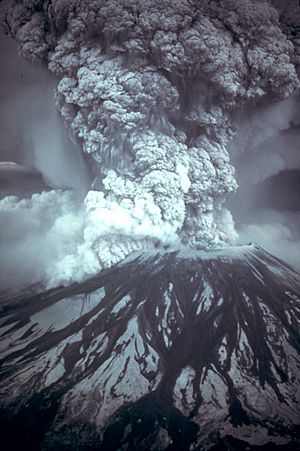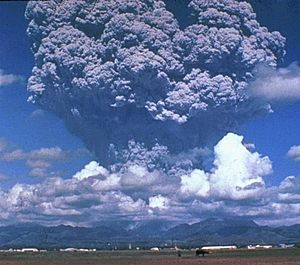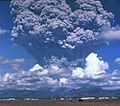Prediction of volcanic activity facts for kids
Volcanoes are powerful natural forces, and predicting when they might erupt is super important! Volcanic eruption forecasting is all about using science and technology to guess when a volcano will erupt and how big the eruption might be. This helps keep people safe and prevents damage to homes and towns. Scientists work hard to understand the clues volcanoes give us before they explode.
Contents
Listening to the Earth: Seismic Waves
When a volcano is about to wake up, it often starts making noise deep underground. These noises are called seismic activity or earthquakes. Even if a volcano usually has small tremors, a big increase in these quakes can mean an eruption is coming. The type of earthquake and where it happens also gives clues.
There are three main types of volcano earthquakes:
- Short-period earthquakes are like normal earthquakes. They happen when rocks crack as hot magma pushes its way up. Think of it like a bone breaking! These quakes show that magma is moving closer to the surface.
- Long-period earthquakes are different. They sound more like a deep hum or clang. Scientists think these happen when gas pressure builds up inside the volcano's "plumbing system." It's like the pipes in your house making noise when water pressure changes.
- Harmonic tremors are a continuous, steady shaking. They often mean that magma is flowing and pushing against the rock below the surface. Sometimes, people and animals can even feel this as a buzzing or humming!
It can be tricky to understand all these earthquake patterns. But if there are more and more quakes, especially the long-period ones and harmonic tremors, it's a strong sign that an eruption is more likely.
Scientists can also listen for very low-frequency sounds, called infrasound, which are too low for humans to hear. There's a special network of stations around the world that listens for these sounds to detect erupting volcanoes.
Earthquake Clues from Past Eruptions
Scientists learned a lot about predicting eruptions by studying past events.
- In 1985, they noticed long-period earthquakes before the eruption of Nevado del Ruiz in Colombia.
- These long-period quakes then helped predict eruptions at Mount Redoubt in Alaska in 1989 and Galeras in Colombia in 1993.
- In December 2000, scientists in Mexico City used these clues to predict an eruption at Popocatépetl. They predicted it would erupt within two days. The government moved tens of thousands of people to safety. Two days later, the volcano erupted, just as predicted! It was the biggest eruption there in a thousand years, but because of the warning, no one was hurt.
Volcano's Breath: Gas Emissions
As magma gets closer to the surface, the gases trapped inside it start to escape. It's like opening a fizzy drink bottle and seeing bubbles escape! Sulfur dioxide is a common gas from volcanoes. If the amount of sulfur dioxide increases, it often means more magma is rising.
For example, before the huge 1991 eruption of Mount Pinatubo in the Philippines:
- On May 13, 1991, sulfur dioxide levels started to rise.
- By May 28, just two weeks later, the amount of sulfur dioxide was ten times higher!
- Mount Pinatubo erupted on June 12, 1991.
Sometimes, gas levels might drop just before an eruption. Scientists think this happens when hardened magma blocks the paths for gases to escape. This blockage builds up pressure inside the volcano, making a big, explosive eruption more likely.
Scientists use special tools called Multi-GAS to measure volcanic gases in real-time. By looking at the amounts of different gases, like CO2 and SO2, they can see if magma is rising and releasing gases, which helps predict activity.
Volcano's Swell: Ground Deformation
When magma builds up near the surface, it can make the ground above it swell or bulge. Scientists carefully measure these changes. They use special equipment to track how much the ground is tilting or swelling.
- If a volcano starts swelling faster, especially with more sulfur dioxide gas and harmonic tremors, it's a strong sign that an eruption is coming soon.
- A famous example is Mount St. Helens before its 1980 eruption. The north side of the volcano bulged outwards as magma pushed up underneath.
- Most of the time, these ground changes are too small for us to see. But scientists with their special tools can detect them and use them to predict eruptions.
- Hawaiian volcanoes often show clear ground deformation. The ground inflates (swells) before an eruption and then deflates (sinks) afterward. This is because their magma chambers are quite shallow, so magma movement is easily seen on the surface.
Heat Clues: Thermal Monitoring
Magma moving, gases escaping, and hot water underground can all change the temperature of a volcano's surface. Scientists can measure these temperature changes in several ways:
- Using special cameras that see heat, either handheld or from airplanes.
- Looking at infrared images from satellites in space.
- Measuring the temperature of hot springs and steam vents directly.
- Creating maps that show where heat is escaping from the ground.
Water Clues: Hydrology
Water around a volcano can also give clues about what's happening inside.
- Water levels and temperature: In wells and boreholes, water levels might rise or suddenly drop just before an eruption. The temperature of hot springs can also increase.
- Mudflows (Lahars): Scientists have developed systems to detect lahars, which are dangerous mudflows made of volcanic ash and water. These systems can warn people if a lahar is coming down a river valley.
- River changes: Sometimes, rivers around a volcano might pick up more sediment or change their width and depth. This can be a sign of changes happening inside the volcano, even without other instruments.
Seeing from Space: Remote Sensing
Remote sensing means using sensors on satellites to gather information about a volcano from far away.
- Cloud sensing: Satellites can see the cold clouds from eruptions and tell them apart from normal weather clouds.
- Gas sensing: Satellites can measure gases like sulfur dioxide and carbon dioxide released by volcanoes. This helps track how much gas is escaping.
- Thermal sensing: Satellites can spot new hot spots on the ground, which might mean new magma is heating up the surface, or that an eruption is happening.
- Deformation sensing: Satellites can also detect tiny changes in the shape of the volcano over time, like if it's uplifting or sinking. This is another way to see ground deformation.
- Forest monitoring: Believe it or not, scientists have even found that changes in how trees grow around a volcano can sometimes predict where new cracks might form before an eruption!
Moving Earth: Mass Movements
Mass movements are things like landslides, rock falls, and mudflows (lahars) that happen on a volcano. These can occur before, during, or after an eruption.
- The most famous example is the huge landslide that happened at Mount St. Helens in 1980. A bulge had formed on the volcano's side, and when it collapsed, it "uncorked" the magma inside, causing a massive side-blast eruption.
- Rock falls often happen when the ground is deforming, which can be a sign of increased activity.
- Mudflows (Lahars) are very dangerous. They are fast-moving rivers of volcanic ash and water that can carry huge rocks, cars, and even houses. They can happen long after an eruption, especially during heavy rain.
Scientists have developed ways to predict lahars, like studying the age and strength of rocks on a volcano. They also use special sensors called Acoustic Flow Monitors (AFM) to listen for ground tremors that could mean a lahar is starting.
Volcano Stories: Local Case Studies
Scientists learn a lot by studying specific volcanoes around the world.
Nyiragongo, Congo
On January 17, 2002, Mount Nyiragongo erupted. A local expert had predicted it a week earlier because he noticed small changes in the ground and knew this volcano was connected to a smaller one that had erupted two years before. Sadly, even though a UN team was sent, the city was declared safe. When the volcano erupted, 40% of the city of Goma was destroyed. This shows how important it is to listen to local experts.
Mount Etna, Italy
British geologists have found a pattern for predicting eruptions at Mount Etna. They noticed a 25-year delay between certain deep events and surface activity. By watching deep changes, they can predict what will happen years later. For example, they predicted that volcanic activity between 2007 and 2015 would be half of what it was in 1972.
Scientists also study the ratio of CO2 to SO2 gases at Mount Etna. An increase in this ratio often means that gas-rich magma is rising, which can lead to an eruption. They saw this pattern before eruptions in July and December 2006.
Another method used at Mount Etna is called 4D microgravity analysis. This uses GPS and radar to measure tiny changes in the volcano's weight and density. These changes can show how magma is moving inside the volcano. Before an eruption in 2001, scientists saw a decrease in Mount Etna's mass, then a sudden increase two weeks before the eruption. This showed magma moving up from deeper storage zones.
Sakurajima, Japan
Sakurajima is one of the most watched volcanoes on Earth! It's very close to Kagoshima City, which has over 500,000 people. Japanese scientists constantly monitor its activity.
Here's how they monitor Sakurajima:
- Ground swelling: The land around the volcano swells as magma builds up. At Sakurajima, the seabed in Kagoshima Bay even rises, making tide levels higher!
- Volcanic earthquakes: As magma flows, it melts and cracks the rock, causing earthquakes 2 to 5 kilometers deep. An underground tunnel helps detect these quakes.
- Water and gas changes: Groundwater levels change, hot spring temperatures rise, and the amount and type of gases released can change. For example, the ratio of HCl gas to SO2 gas increases just before an eruption.
- Tiltmeters: These tools measure tiny movements of the mountain as an eruption gets closer.
- Seismometers: These detect earthquakes right under the crater, signaling that an eruption is about to begin, sometimes just 1 to 1.5 seconds before an explosion!
- Settling: After an explosion, tiltmeters record the volcano settling back down.
Ecuador
In Ecuador, a team of scientists at the National Polytechnic School in Quito watches over the many active volcanoes in the Andes Mountains and the Galápagos Islands. Ecuador is part of the Ring of Fire, where most of the world's earthquakes and big eruptions happen. They closely study volcanoes like Tungurahua, which has had several major eruptions since 1999.
Images for kids
See also





